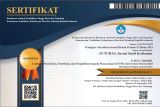Adistia, S. (2020). Kerudung di Mata Gus Dur. Islamramah.Co. https://www.islamramah.co/2020/12/4826/kerudung-di-mata-gus-dur.html
Affan, H. (2015). Mengapa jilbab syar’i merebak dan menjadi trend? Bbc.Com. https://www.bbc.com/indonesia/majalah/2015/06/150621_magazine_bisnis_trendmodejilbab
Akmaliah, S. M. N. dan W. (2021). Mempertanyakan Ulang Jilbab Sebagai Pemaksaan. Pmb.Brin.Go.Id. https://pmb.brin.go.id/mempertanyakan-ulang-jilbab-sebagai-pemaksaan/
Akmaliah, W. (2023). Cadar dan Tradisi Diskursif “Taat” bagi Perempuan Muslim Indonesia. Studia Islamika, 30(1). https://journal.uinjkt.ac.id/index.php/studia-islamika/article/view/33374
Alghafli, Z., Marks, L. D., Hatch, T. G., & Rose, A. H. (2017). Veiling in Fear or in Faith? Meanings of the Hijab to Practicing Muslim Wives and Husbands in USA. Marriage and Family Review, 53(7), 696–716. https://doi.org/10.1080/01494929.2017.1297757
Ansor, M. (2014). Being woman in the land of shari’a: Politics of the female body, piety and resistance in Langsa, Aceh. Al-Jami’ah, 52(1), 59–83. https://doi.org/10.14421/ajis.2014.521.59-83
Badr, H. (2004). Islamic identity re‐covered: Muslim women after September 11th. In Culture and Religion (Vol. 5, Issue 3, pp. 321–338). https://doi.org/10.1080/0143830042000294406
Bilal Ramadhan. (2023). Komnas Perempuan Bantah Pakaian Terbuka Jadi Pemicu Pelecehan. News.Republika.Co.Id. https://news.republika.co.id/berita/ro9j5d330/komnas-perempuan-bantah-pakaian-terbuka-jadi-pemicu-pelecehan
Bilge, S. (2010). Beyond subordination vs. resistance: An intersectional approach to the agency of veiled muslim women. Journal of Intercultural Studies, 31(1), 9–28. https://doi.org/10.1080/07256860903477662
Brünig, B., & Fleischmann, F. (2015). Understanding the veiling of muslim women in the Netherlands. Journal for the Scientific Study of Religion, 54(1), 20–37. https://doi.org/10.1111/jssr.12166
Droogsma, R. A. (2007). Redefining Hijab: American Muslim women’s standpoints on veiling. Journal of Applied Communication Research, 35(3), 294–319. https://doi.org/10.1080/00909880701434299
Dwyer, C. (1999). Veiled meanings: young British Muslim women and the negotiation of differences. Gender, Place and Culture, 6(1), 5–26. https://doi.org/10.1080/09663699925123
Fadillah, G. (n.d.). CADAR IDENTITAS SEORANG MUSLIMAH ATAU BUDAYA ARAB. Dppai.Uii.Ac.Id. Retrieved June 25, 2023, from https://dppai.uii.ac.id/cadar-identitas-seorang-muslimah-atau-budaya-arab/
Fauzi, M. R. (2021). Ungkap Cara Berhijab Keluarga Gus Dur, Yenny Wahid: Terdapat Beragam Pandangan Ulama Tentang Hijab. Jabar.Nu.or.Id. https://jabar.nu.or.id/nasional/ungkap-cara-berhijab-keluarga-gus-dur-yenny-wahid-terdapat-beragam-pandangan-ulama-tentang-hijab-M9deM
Hasse Jubba, Nugroho, D., Destrianti, G., & Sholikhah, S. (2021). The Hijrah Phenomenon in Tertiary Education in Indonesian: A Multidimensional Analysis of Moderate Religious Values. Al-Ulum, 21(1), 27–49. https://doi.org/10.30603/au.v21i1.2173
Hijup. (2015). 7 Alasan Hijab Syar’i Banyak Disukai. Hijup.Com. https://www.hijup.com/magazine/7-alasan-hijab-syari-banyak-disukai/
Isti’anah. (2021). Islam Mengharamkan Kekerasan Seksual terhadap Perempuan. Mubadalah.Id. https://mubadalah.id/islam-haramkan-kekerasan-seksual-terhadap-perempuan/
Izharuddin, A. (2019). Larangan Cadar Tak Masuk Akal, Tak Seperti Alasan Perempuan Memakainya. Magdalene.Co. https://magdalene.co/story/pahami-mereka-yang-memakai-cadar/
Khushbakht, S. M. (2022). The Aurat March (2018-2022) in the Context of Gendered-Islamophobia: A Case of Muslim Women's Identity in Pakistan. Journal of Islamic Thought and Civilization, 12(2), 271–285.
Kodir, F. A. (2000). Aurat dan Fitnah Tubuh Perempuan. Kupipedia.Id. https://kupipedia.id/index.php?title=Aurat_dan_Fitnah_Tubuh_Perempuan&mobileaction=toggle_view_desktop
Kusciati, K. P. (2013). Trendy Veils: Young Javanese Women Between Islam and Modernity. Humaniora, 25(3), 308–323.
Lubis, M. R. (n.d.). Aurat Perempuan dan Perkembangan Zaman. Cariustadz.Id. Retrieved June 25, 2023, from https://cariustadz.id/artikel/detail/aurat-perempuan-dan-perkembangan-zaman
Mu’arif. (2018). Menengok Jilbab Muhammadiyah Zaman Dulu. Alif.Id. https://alif.id/read/muarif/menengok-jilbab-muhammadiyah-zaman-dulu-b209433p/
Muallifah. (2022). Mengenal Konsep Feminisme Islam Nurcholish Madjid. Mubadalah.Id. https://mubadalah.id/mengenal-konsep-feminisme-islam-nurcholish-madjid/
Muhammad, H. (2020). Jilbab, Hijab, dan Kesalehan (Bagian 1). Mubadalah.Id. https://mubadalah.id/jilbab-hijab-dan-kesalehan-bagian-1/
Muhammadiyah, T. F. M. T. dan T. P. (2003). AURAT DAN JILBAB. Http://Tarjih.Muhammadiyah.or.Id/. http://tarjih.muhammadiyah.or.id/muhfile/tarjih/download/Fatwa 13-2003_aurat dan jilbab.pdf
Nashrullah, N. (2020). Aurat Perempuan, Haruskah Cadar atau Cukup Jilbab? Islamdigest.Republika.Co.Id. https://islamdigest.republika.co.id/berita/qeydtg320/aurat-perempuan-haruskah-cadar-atau-cukup-jilbab
Nisa, E. F. (2012). Embodied Faith: Agency and Obedience among Face-veiled University Students in Indonesia. Asia Pacific Journal of Anthropology, 13(4), 366–381. https://doi.org/10.1080/14442213.2012.697187
Qurtuby, S. Al. (2016). Hijab, Aurat dan Perkosaan. Redaksiindonesia.Com. https://redaksiindonesia.com/read/hijab-aurat-dan-perkosaan-html
Ramdlan, M. M., & Dja’far, A. M. (2019). Bercadar Dalam Islam: Sejarah Penggunaan Cadar, Hukum Mewajibkan Cadar kepada Perempuan, Sikap Menghadapi Pihak yang Mewajibkan Bercadar. Wahid Foundation.
Ramírez, Á. (2015). Control over female ‘Muslim’ bodies: culture, politics and dress code laws in some Muslim and non-Muslim countries. Identities, 22(6), 671–686. https://doi.org/10.1080/1070289X.2014.950972
Rene, K. (2017). How YouTube made the hijab cool : race , gender , and authority in the American ummah.
Smith-Hefner, N. J. (2007a). Javanese women and the veil in post-soeharto Indonesia. Journal of Asian Studies, 66(2), 389–420. https://doi.org/10.1017/S0021911807000575
Smith-Hefner, N. J. (2007b). Javanese women and the veil in post-soeharto Indonesia. Journal of Asian Studies, 66(2), 389–420. https://doi.org/10.1017/S0021911807000575
Sunesti, Y. (2020). Riset ungkap 3 hal baru tentang perempuan muda bercadar di Indonesia. Theconversation.Com. https://theconversation.com/riset-ungkap-3-hal-baru-tentang-perempuan-muda-bercadar-di-indonesia-152006
swararahima. (2018a). Jilbab dan Aurat. Swararahima.Com. https://swararahima.com/2018/08/07/jilbab-dan-aurat/
swararahima. (2018b). Menutup Aurat. Swararahima.Com. https://swararahima.com/2018/08/07/menutup-aurat/
tafsirweb. (n.d.). Surat An-Nur Ayat 31. Tafsirweb.Com. Retrieved July 15, 2023, from https://tafsirweb.com/6159-surat-an-nur-ayat-31.html
Tariq-munir, E. (2014). The Dynamics of Wearing hijab for Muslim American Women in the United States. Iowa State University, 72. htps://lib.dr.iastate.edu/etd/13842
Wagner, W., Sen, R., Permanadeli, R., & Howarth, C. S. (2012). The veil and Muslim women's identity: Cultural pressures and resistance to stereotyping. Culture & Psychology, 18(4), 521–541.
Wahid, K. A. (1983). Kerudung dan Kesadaran Beragama. Gusdur.Net. https://gusdur.net/kerudung-dan-kesadaran-beragama/
Yurisa, P. R., Muassomah, M., & Abdullah, I. (2020). The Meaning of Hijrah among Niqobers in Social Media. Analisa: Journal of Social Science and Religion, 5(02), 201–220. https://doi.org/10.18784/analisa.v5i02.1200
Zine, J. (2006). Unveiled sentiments: Gendered islamophobia and experiences of veiling among muslim girls in a canadian islamic school. Equity and Excellence in Education, 39(3), 239–252. https://doi.org/10.1080/10665680600788503
Zulfiana. (2022). Kenapa Harus Syar’i. Komunitasindonesiaberhijab.Ning.Com. https://komunitasindonesiaberhijab.ning.com/blog/kenapa-harus-syar-i

 (UIN Mataram)
(UIN Mataram) 




.png)







